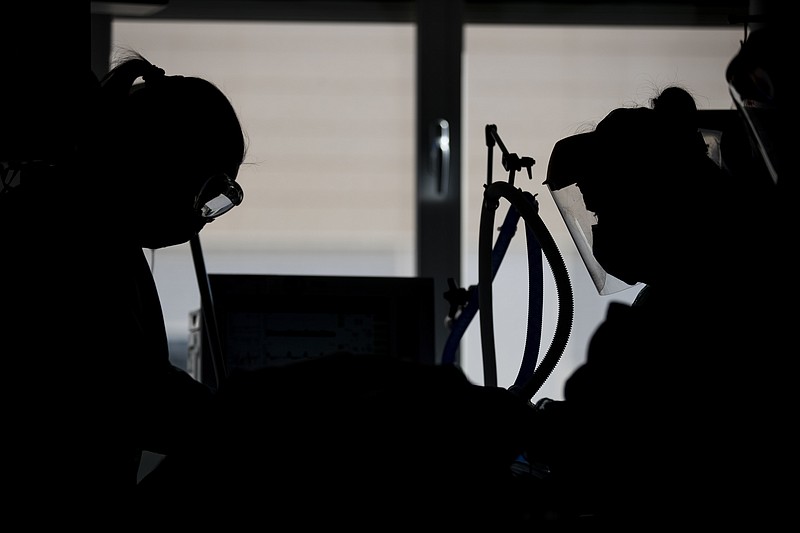ROME -- Europe's second wave of coronavirus infections has struck well before flu season even started, with intensive care wards filling up again and bars shutting down. Making matters worse, authorities say, is a widespread case of "covid-fatigue."
Record high daily infections in several eastern European countries and sharp rebounds in the hard-hit west have made clear that Europe never really crushed the covid-19 curve as hoped after springtime lockdowns.
Spain this week declared a state of emergency for Madrid amid increasing tensions between local and national authorities over virus containment measures. Germany offered up soldiers to help with contact tracing in newly flaring hot spots. Italy mandated masks outdoors and warned that for the first time since the country became the European epicenter of the pandemic, the health system was facing "significant critical issues" as hospitals fill up.
The Czech Republic's "Farewell covid" party in June, when thousands of Prague residents dined outdoors at a 500-yard long table across the Charles Bridge to celebrate their victory over the virus, was seen as premature now that the country has the highest per-capita infection rate on the continent, at 398 per 100,000 residents.
"I have to say clearly that the situation is not good," the Czech interior minister, Jan Hamacek, acknowledged this week.
Epidemiologists and residents alike are pointing the finger at governments for having failed to seize on the summertime lull in cases to prepare adequately for the expected autumn onslaught, with testing and ICU staffing still critically short. In Rome this week, people waited in line for 8-10 hours to get tested, while front-line medics from Kiev to Paris found themselves once again pulling long, short-staffed shifts in overcrowded wards.
"When the state of alarm was abandoned, it was time to invest in prevention, but that hasn't been done," lamented Margarita del Val, viral immunology expert with the Severo Ochoa Molecular Biology Center, part of Spain's top research body, CSIC.
"We are in the fall wave without having resolved the summer wave," she told an online forum this week.
Tensions are rising in cities where new restrictions have been reimposed, with hundreds of Romanian hospitality workers protesting this week after Bucharest once again shut down the capital's indoor restaurants, theaters and dance venues.
"We were closed for six months, the restaurants didn't work and yet the number of cases still rose," said Moaghin Marius Ciprian, owner of the popular Grivita Pub 'n Grill who took part in the protest. "I'm not a specialist but I'm not stupid either. But from my point of view it's not us that have the responsibility for this pandemic."
As infections rise in many European countries, some -- including Belgium, Netherlands, the United Kingdom, Spain and France -- are diagnosing more new cases every day per capita than the United States, according to the seven-day rolling averages of data kept by Johns Hopkins University. On Friday, France, with a population of about 70 million, reported a record 20,300 new infections.
Experts say Europe's high infection rate is in large part a result of expanded testing that is turning up far more asymptomatic positives than during the first wave, when only the sick could get a test.
But the trend is nevertheless alarming, given the flu season hasn't even begun, schools are open for in-person learning and the cold weather hasn't yet driven Europeans indoors, where infection can spread more easily.
"We're seeing 98,000 cases reported in the last 24 hours. That's a new regional record. That's very alarming," said Robb Butler, executive director of the WHO's Europe regional office. While part of that is due to increased testing, "It's also worrisome in terms of virus resurgence."
It's also worrisome given many countries still lack the testing, tracing and treating capacity to deal with a second wave of pandemic when the first wave never really ended, said Dr. Martin McKee, professor of European public health at the London School of Hygiene and Tropical Medicine.
"They should have been using the time to put in place really robust 'find, test, trace, isolate' support systems. Not everybody did," McKee said. "Had they done that, then they could have identified outbreaks as they were emerging and really gone for the sources."
There is some good news, however. Dr. Luis Izquierdo, assistant director of emergencies at the Severo Ochoa Hospital in Madrid said that at least now doctors know what therapies work. During the peak of the epidemic in March and April, doctors in hardest-hit Spain and Italy threw every drug they could think of at patients -- hydroxychloroquine, lopinavir, ritonavir -- with limited success.
"Now we hardly use those drugs as they hardly have any effect," he said. "So in this sense we have had a victory because we know so much more now."
But treating the virus medically is only half the battle. Public health officials are now dealing with a surge in anti-mask protests, virus negationists and residents who are simply sick and tired of being told to keep their distance and refrain from hugging their loved ones.
The WHO this week shifted gears from giving medical advice to combat infections to giving psychological advice on how to nudge virus-weary Europeans to keep up their guard amid "covid-fatigue" that is sweeping the continent.
"Fatigue is absolutely natural. It's to be expected where we have these prolonged crises or emergencies," said the WHO's Butler.
The WHO this week put out new advice for governments to consider more social, psychological and emotional factors when deciding on lockdowns, closures or other restrictions -- a nod to some in the field who say the mental health toll of lockdowns is worse than the virus itself.









